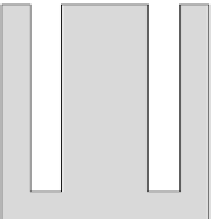Geology Reference
In-Depth Information
behind the survey vessel. Operating voltages are typi-
cally 3.5-4.0 kV and peak currents may exceed 200 A.
This electrical discharge leads to the formation and rapid
growth of a plasma bubble and the consequent genera-
tion of an acoustic pulse. For safety reasons, sparkers are
increasingly being replaced by other sources.
Boomers
comprise a rigid aluminium plate attached
below a heavy-duty electrical coil by a spring-loaded
mounting. A capacitor bank is discharged through the
coil and the electromagnetic induction thus generated
forces the aluminium plate rapidly downwards, setting
up a compressional wave in the water. The device is
typically towed behind the survey vessel in a catamaran
mounting.
Sparkers and boomers generate broad-band acoustic
pulses and can be operated over a wide range of energy
levels so that the source characteristics can to some ex-
tent be tailored to the needs of a particular survey. In gen-
eral, boomers offer better resolution (down to 0.5 m) but
more restricted depth penetration (a few hundred metres
maximum).
Pingers
consist of small ceramic piezoelectric
transducers, mounted in a towing fish, which, when ac-
tivated by an electrical impulse, emit a very short, high-
frequency acoustic pulse of low energy.They offer a very
high resolving power (down to 0.1 m) but limited pene-
tration (a few tens of metres in mud, much less in sand or
rock). They are useful in offshore engineering applica-
tions such as surveys of proposed routes for submarine
pipelines.
Chirp
systems are electro-mechanical transducers that
produce an extended, repeatable, source waveform
which allows greater energy output. This longer signal
can be compressed in processing to give greater resolu-
tion and/or better signal-to-noise ratio.
Further discussion of the use of air guns, sparkers,
boomers and pingers in single-channel seismic reflec-
tion profiling systems is given in Section 4.15.
Shunt
resistor
Leaf spring
support
Coil output
to seismic
amplifier
N
S
N
Permanent
magnet
Coil
Fig. 3.19
Schematic cross-section through a moving-coil
geophone.
faithfully requires knowledge of the components of
motion in the vertical, east-west and north-south direc-
tions. Historically, the solution has been to measure the
vertical component of velocity only. The vertical com-
ponent has maximum sensitivity to P-waves relative to
S-waves and surface waves.Velocity is technically easier
to detect and record than either displacement or acceler-
ation. Recording only one component minimizes the
technical problems of data storage.
Devices used on land to detect seismic ground mo-
tions are known as
seismometers
or
geophones
. In water, the
passage of a compressional seismic wave is marked by
transient pressure changes and these are detected by
hy-
drophones
towed or suspended in the water column or, in
very shallow water, laid on the sea bed. Hydrophones
may also be used in the water-saturated ground condi-
tions encountered in swamps or marshland. Detectors
may comprise individual geophones or hydrophones,
or arrays of these devices connected together in series or
parallel to provide a summed output.
Geophones are made to several designs, but the most
common is the
moving-coil
geophone (Fig. 3.19). A
cylindrical coil is suspended from a spring support in the
field of a permanent magnet which is attached to the in-
strument casing.The magnet has a cylindrical pole piece
inside the coil and an annular pole piece surrounding the
coil.The suspended coil represents an oscillatory system
with a resonant frequency determined by the mass of the
coil and the stiffness of its spring suspension.
The geophone is fixed by a spike base into soft ground
or mounted firmly on hard ground. It moves in
3.8.2 Seismic transducers
Conversion of the ground motion to an electrical signal
requires a transducer which is sensitive to some compo-
nent of the ground motion, and can record the required
range of frequencies and amplitudes without distortion.
The first issue is which component of the motion to
measure. As the ground oscillates, it is possible to mea-
sure either the displacement, velocity or acceleration of
the ground particles as the wave passes.The ground mo-
tion also takes place in three dimensions. To record it
















